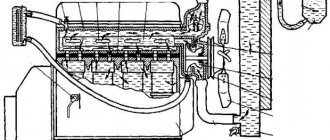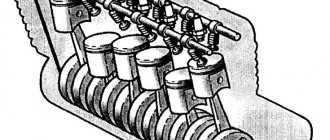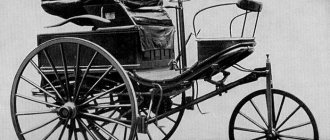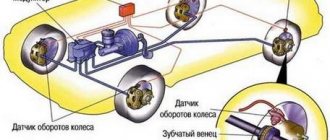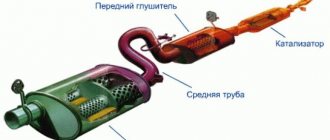Design and principle of operation of the headlight range control
It is worth noting that the operating principle of different types of headlight range control units is approximately the same. At the same time, a distinction is made between automatic and manual settings. In the latter version, the position of the headlights is adjusted using a special regulator installed inside the car, and with the help of its rotation, the driver independently changes the angle of the optics. In the first case, the electronics automatically configure everything itself, depending on the landing of the car.
Manual headlight range control
This headlight range control is installed on many budget cars, so it is familiar to a large number of car enthusiasts. As the name suggests, the corrector is activated directly by the driver. To do this, as a rule, you just need to turn the wheel, or as it is also called, the rotary switch. The electromechanical drive of the headlight range control is most often used, so we will consider it.
The adjustment wheel usually has digital or graphic markings that indicate the position of the headlights. Adjustments are made by the driver as necessary, depending on the vehicle’s load and changes in its tilt in the longitudinal direction relative to the center of gravity.
Simply put, if three people sat in the back seat, and you had to put four bags of potatoes for your mother-in-law in the trunk, then obviously the back of the car will lower and the front will rise, causing the headlights to shine too high and blind oncoming drivers.
To prevent this from happening, you need to turn the wheel so that the beam of light goes down.
Turning the knob gives the corresponding command to the gear motor, which is needed to turn the headlight to a certain angle. In fact, a gear motor is nothing more than a worm gear, which is necessary to convert the rotational movement of the electric motor (located inside the gear motor) into the translational movement of the rod, which directly acts on the headlight, changing its angle.
Structurally, the headlight is hinged at the top, and the rod with a ball end (resting against a spherical latch) holds the lower edge of the headlight. And it is the back and forth movement of the lower part of the headlight, with the upper attachment point remaining unchanged, that gives the necessary change in the angle of inclination.
A manual headlight leveler is very simple, very reliable and, most importantly, a useful device, but it has one very significant drawback: most drivers forget to use it and blind their colleagues, despite the fact that they have the opportunity not to do so.
Automatic headlight leveling system
Automatic headlight leveling is a more advanced technology because it does not require any action from the driver. The cut-off line is adjusted automatically based on sensor readings.
Automatic headlight leveling can be installed on vehicles equipped with either halogen or xenon headlights. For xenon, this is even necessary, since this type of headlight emits light of very high intensity, and in the absence of auto-corrector, it can pose a serious threat to traffic safety.
As for the design of the headlight auto-corrector, the following elements can be distinguished:
- Control block;
- sensors that measure the vehicle's ground clearance at various points;
- device that adjusts the headlights (actuator).
Typically, the system uses two or three sensors that measure ground clearance. Either one sensor or a pair can be installed at the front. And one sensor is located at the back.
Early systems used potentiometric sensors, but they were not reliable enough, so they have now been replaced by non-contact angle sensors.
The operating principle of these sensors is based on the Hall effect. The mechanism of operation of the sensor is quite simple.
Structurally, the sensor consists of a rotor (moving part), with permanent magnets built into it, and a stator (fixed part), which, in fact, is a Hall sensor.
The sensor is attached to the bottom and is connected to the suspension using a rod. The change in suspension travel is transmitted through the rod to the rotor, which rotates, causing a change in the magnetic flux, which is detected by the Hall sensor.
The magnitude of the change in the magnetic flux is subsequently recalculated by the control unit into the required angle of rotation of the headlights, and the corresponding signal is sent to the actuator. In its work, the control unit takes into account not only the angle of inclination of the vehicle, but also the speed, as well as the nature of the vehicle’s movement.
Types of light sources
In modern cars, there are several types of headlights depending on the light sources used.
Incandescent lamps
The simplest and most accessible, but already outdated source is incandescent lamps. Their operation is ensured by a tungsten filament located in an airless glass flask. When voltage is applied to the lamp, the filament heats up and a glow begins to emanate from it. However, with constant use, tungsten tends to evaporate, which ultimately leads to the filament breaking. As new technologies developed, incandescent lamps could not withstand the competition and ceased to be used in automotive optics.
Halogen lamps
Despite the fact that the principle of operation of halogen lamps is similar to incandescent lamps, the service life of halogen lamps is many times longer. Vapors of halogen gas (iodine or bromine) pumped into the lamp help to increase the operating time of lamps, as well as to increase the level of illumination. The gas interacts with the tungsten atoms on the filament. Evaporating, tungsten circulates through the bulb, and then, connecting with the filament, settles on it again. This system allows you to extend the lamp life to 1,000 hours or more.
Xenon (gas discharge) lamps
Xenon lamps produce light by heating a gas under high voltage. However, the lamp can only be ignited and powered using special equipment, which increases the final cost of the optics. But the costs are justified: xenon headlights can last 2,000 hours or more.
Most often, bi-xenon headlights are used in the headlight system, combining low and high beam.
LED bulbs
LEDs are the most modern and increasingly popular light source. The service life of such lamps reaches 3,000 hours or more. With the lowest energy consumption, LEDs are able to provide a sufficient level of illumination. Such lamps are actively used in both the external and internal lighting systems of a car.
